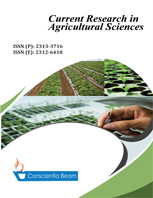Risk Factors for the Contamination of Wild Stomoxys niger niger Macquart 1851 (Diptera: Muscidae) with the Foot-and-Mouth Disease Virus
DOI:
https://doi.org/10.18488/journal.68.2019.62.95.108Abstract
The study aimed at detecting the foot-and-mouth disease virus (FMDV) RNA in Stomoxys niger niger and cattle. Flies were collected using a Vavoua trap pitched 50m from the center of the herd and by net-catches on clinically sick (n=5) and symptomless cattle (n=5). Vesicular Epithelia Tissues (VETs) from sick cattle were analyzed by real time reverse transcriptase polymerase chain reaction (rt RT PCR) and serum from randomly selected animals without clinical signs was examined by serological test (NSP-ELISA Kit) for the presence of FMDV antibodies. Of a total of 568 Stomoxys trapped using the Vavoua trap, two species were identified namely 196 S. niger niger (34.51 %, 9. 33 Snn/t/d), 101 S. omega (17.78%, 4.80 so/t/d) and 271 non-biting Musca sp. (47.71%, 12.90 m/vavoua and day). The dissected mouth and legs of each fly caught were screened for FMDV using the rt RT PCR. FMDV RNA was found in the epithelial vesicles of all clinically sick animals (n=5, with mean Ct of 27.98456) and 3 out of 5 were serologically positive in the clinically in-apparent cattle group. The overall S. n. niger (most abundant species) contamination rate with the FMDV irrespective of collection method was 40.3 % with females (49.0 %) being slightly more contaminated than males (21.7%) (OR =0.45, P= 0.1506) and legs being more often positive than mouth-parts (P=0.02002). Flies were contaminated less frequently on animals without clinical signs than those on animals with clinical signs, but this difference was not significant (P=0.69680).

